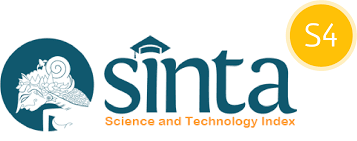Clustering Data Pasien Covid Berdasarkan Usia dan Gejala Menggunakan Algoritma K-Means
DOI:
https://doi.org/10.29408/jit.v6i2.17488Keywords:
Data Mining, Clustering, K-Means, Rapidminer, Covid-19 data.Abstract
The case of COVID-19 is familiar to everyone's ears, but there are still a lot of people who don't care about the importance of maintaining health protocols because of the lack of education about the COVID-19 virus. The increase in cases of covid-19 is getting higher from year to year with increasingly diverse patient symptoms, therefore researchers are interested in conducting research on grouping covid patients based on age and symptoms using the k-means algorithm clustering method. Rapidminer 5 is an application used to process patient data. covid-19, but before processing the data, several processes and stages will be carried out including data cleaning, data selection, integration, transformation until the data is ready to be processed using the rapidmider application. From the result obtained cluster 1 wich amounted to 866 items it was certain that it consisted of patients aged 42-81 years with 50 deaths, while in the cluster 2 wich amounted to 1566 items with an age range of 1-41 years with 16 death. The k-means algorithm clustering method is the most appropriate solution for processing covid patient data. -19, this is because the level of accuracy produced is quite effective. The results obtained in grouping Covid-19 patient data using the k-means algorithm can be used as evaluation material by the government, especially the East Lombok District Health Office in dealing with cases of the increasingly high spread of COVID-19.
References
A. Amalia and N. Sa’adah, “Dampak Wabah Covid-19 Terhadap Kegiatan Belajar Mengajar Di Indonesia,” J. Psikol., vol. 13, no. 2, pp. 214–225, 2020, doi: 10.35760/psi.2020.v13i2.3572.
D.Pittara, “COVID-19 adalah penyakit akibat infeksi virus severe acute respiratory syndrome coronavirus 2 (SARS-CoV-2).” https://www.alodokter.com/covid-19
Fadlahu Warsita, “Penerapan Metode Clustering Dengan Algoritma K-Means Untuk Mengelompokkan Data Gizi Bayi Pada Pelayanan Posyandu Desa Perian Kecamatan Montong Gading,” p. 2, 2021.
S. Kaputama et al., “Data Mining Pengelompokan Anak Stunting Berdasarkan Usia , Penyebab dan Pekerjaan Orang Tua Dengan Menggunakan Metode Clustering ( Studi Kasus : Dinas Kesehatan Kabupaten Langkat ),” 2021.
M. M. K-means, A. Solichin, and K. Khairunnisa, “Klasterisasi Persebaran Virus Corona ( Covid-19 ) Di DKI Jakarta,” vol. 5, no. 2, 2020.
M. Saiful and S. Samsuddin, “Implementasi Algoritma Naive Bayes Untuk Memprediksi Predikat Ketuntasan Belajar Siswa Pasca Pandemi Covid 19,” Infotek J. Inform. dan Teknol., vol. 4, no. 1, pp. 29–38, 2021, doi: 10.29408/jit.v4i1.2982.
M. Saiful, L. M. Samsu, and F. Fathurrahman, “Sistem Deteksi Infeksi COVID-19 Pada Hasil X-Ray Rontgen menggunakan Algoritma Convolutional Neural Network (CNN),” Infotek J. Inform. dan Teknol., vol. 4, no. 2, pp. 217–227, 2021, doi: 10.29408/jit.v4i2.3582.
N. Dwitri, J. A. Tampubolon, S. Prayoga, F. I. R.H Zer, and D. Hartama, “Penerapan Algoritma K-Means Dalam Menentukan Tingkat Penyebaran Pandemi Covid-19 Di Indonesia,” J. Teknol. Inf., vol. 4, no. 1, pp. 128–132, 2020, doi: 10.36294/jurti.v4i1.1266.
J. A. Ginting, T. Informatika, and U. B. Mulia, “DATA MINING UNTUK ANALISA PENGAJUAN KREDIT DENGAN MENGGUNAKAN METODE LOGISTIK REGRESI Data Mining To Analisizes Loan Proposal Using Regresion Logistic Method,” no. 2, pp. 164–169, 2019.
S. Informasi and S. Royal, “Seminar Nasional Royal (SENAR) 2018,” vol. 9986, no. September, 2018.
A. Bastian et al., “PENERAPAN ALGORITMA K-MEANS CLUSTERING ANALYSIS PADA PENYAKIT MENULAR MANUSIA (STUDI KASUS KABUPATEN MAJALENGKA),” no. 1, pp. 26–32, 2018.
H. Priyatman, F. Sajid, and D. Haldivany, “Klasterisasi Menggunakan Algoritma K-Means Clustering untuk Memprediksi Waktu Kelulusan,” vol. 5, no. 1, pp. 62–66, 2019.
E. Prasetyo, Data Mining Mengolah Data Menjadi Informasi Menggunakan Matlab. Jogjakarta: ANDI, 2014.
E. Prasetyo, Data Mining : Konsep Dan Aplikasi Menggunakan MATLAB. Yogyakarta: ANDI, 2012.
D. R. M.Makmum Effendi, “PREDIKSI PENJUALAN PRODUK ROTI MENGGUNAKAN ALGORITMA C4.5 PADA PT. PRIMA TOP BOGA,” SIGMA- J. Teknol. Pelita Bangsa, vol. 9, no. September, 2018.
Downloads
Published
How to Cite
Issue
Section
License
Semua tulisan pada jurnal ini menjadi tanggung jawab penuh penulis. Jurnal Infotek memberikan akses terbuka terhadap siapapun agar informasi dan temuan pada artikel tersebut bermanfaat bagi semua orang. Jurnal Infotek ini dapat diakses dan diunduh secara gratis, tanpa dipungut biaya sesuai dengan lisense creative commons yang digunakan.
Jurnal Infotek is licensed under a Creative Commons Attribution 4.0 International License.
Statistik Pengunjung




